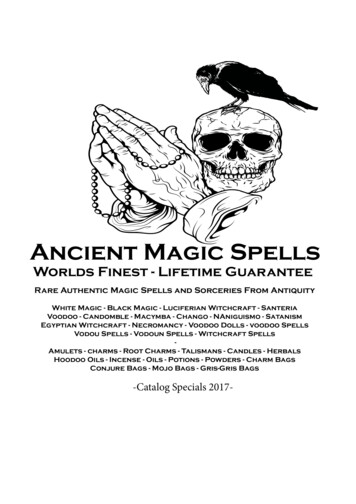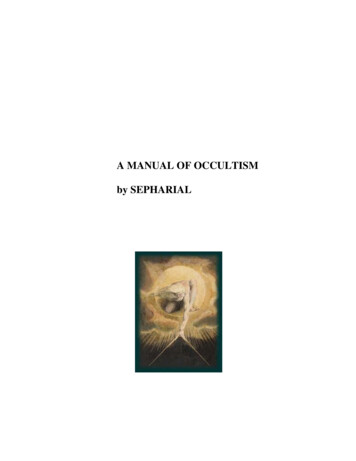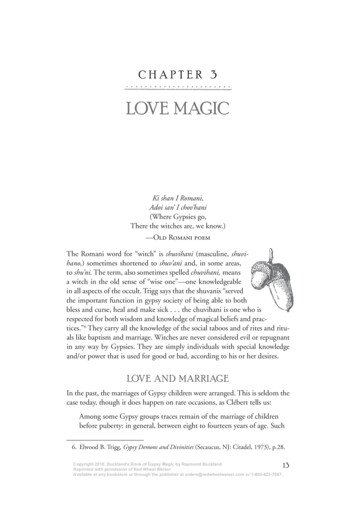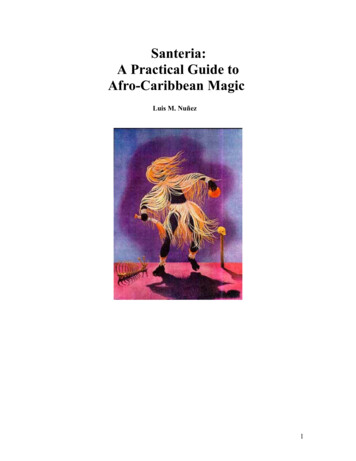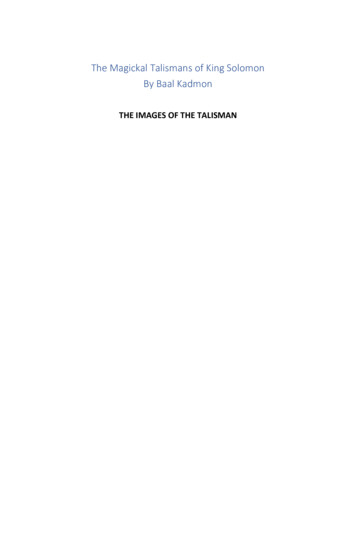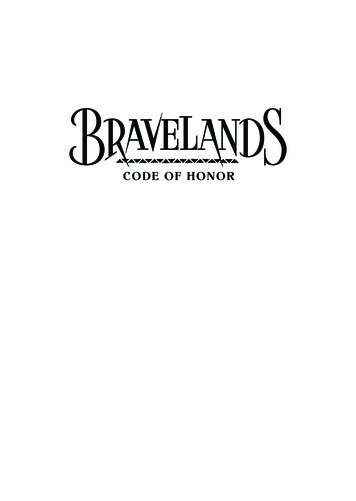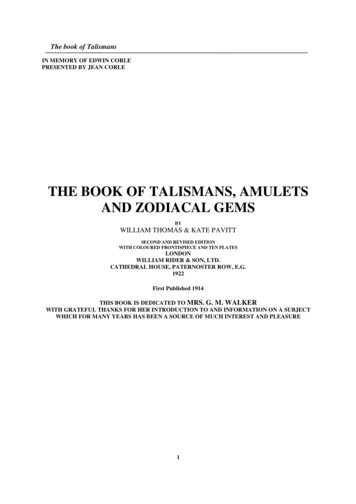
Transcription
The book of TalismansIN MEMORY OF EDWIN CORLEPRESENTED BY JEAN CORLETHE BOOK OF TALISMANS, AMULETSAND ZODIACAL GEMSBYWILLIAM THOMAS & KATE PAVITTSECOND AND REVISED EDITIONWITH COLOURED FRONTISPIECE AND TEN PLATESLONDONWILLIAM RIDER & SON, LTD.CATHEDRAL HOUSE, PATERNOSTER ROW, E.G.1922First Published 1914THIS BOOK IS DEDICATED TO MRS. G. M. WALKERWITH GRATEFUL THANKS FOR HER INTRODUCTION TO AND INFORMATION ON A SUBJECTWHICH FOR MANY YEARS HAS BEEN A SOURCE OF MUCH INTEREST AND PLEASURE1
The book of TalismansPrefaceTHE subject of Talismans and Gems of the Zodiac covers a wide area, and the difficulty ofarriving at a definite conclusion is increased because of the varying opinions between writers onthese subjects as to the stones referred to, or intended by the Ancients, complicated still furtherby the different languages from which these records have been translated, and where Month orZodiacal gems are referred to many of the writers are obviously unacquainted with Astrology orAstronomy.The present volume, being the result of many years of study and research, it is not easy in allcases to specify the original source of our information, which has been collected, not only fromancient and modern writings, but also from personal experience and experiments, noted at thelime they occurred, long before this book was contemplated. Again, we find that many, and moreespecially modern authors, quote from one another in places, and the original source of theinformation is obscure; we have, therefore, endeavoured to give as far as possible our authorities,although, owing to the antiquity of the subject, much is necessarily left to deduction andconjecture; and it is more than probable there may be unintentional omissions, to remedy whichwe give a list of books that we have at different times consulted and studied with advantage.We have endeavoured throughout to make the subjects dealt with as interesting as possible ,believing that the symbols expressing the faiths of bygone days form the basis of occult forces, aproper understanding of which is becoming more and more recognised by scientists as necessaryin the interests of progress at the present day.It will be noticed that many of the gems have similar qualities attributed to them which,according to the ancient authorities, were specifically arranged for the benefit of those typeswhose planetary aspects brought them into harmony with the particular stone specified.With regard to characteristics dealt with in the second part of the book, this must be regardedas general, and liable to variation according to the remaining Planetary influences, which wouldbe indicated in a horoscope. With this proviso, the information given will be found reliable andvery helpful in giving a knowledge of our own dispositions and those of our friends andassociates and should pave the way to a sympathy and understanding impossible without thisknowledge. It will also afford a simple and easy means of at least proving there is something inAstrology, and if interest is aroused the fullest information may be obtained by a study of thebooks mentioned, dealing with the subject.We have greatly benefited from the assistance given us by Mrs. G. M. Walker in lending usscarce and valuable books for reference, and by G. H. Greenop, Esq., kindly translating many oldGreek and Latin writings; we should also like to acknowledge our obligations to the Directors ofthe British Museum for the facilities given in obtaining information, and their permission tomake drawings from the actual Talismans in their collections.WM. THOS. PAVITT17 HANOVER SQUARE, LONDON, W. 3rd August, 19142
The book of TalismansCONTENTSPART IChapter IThe Psychic and Magnetic Influence of Talismans and GemsChapter IITalismans of Primitive Races - The Axe Arrow-head - The Swastika - The Serpent - TheInterlaced TrianglesChapter IIIThe Tau Cross - Aum Ma Ni Pad Me Hum - Indian Talismans - Ganesa the Elephant-headed Hanuman the Monkey God - The Eight Glorious Emblems of Buddha - The Wheel of Life - TheConch Shell - The Two Fishes - The Lucky Diagram - The Lotus- The Frog - The Three GemsChapter IVTalisman for Wisdom Buddha’s Footprints - The Dorje - Knots - Chinese Talismans - TheTrigrams - The Five Bats - The Goose - Stork - Pine Tree - Peach - Lucky Sentence - ThePhoenix - The Dragon - Horse Hoof - Siva’s Charm - The Money Sword - Red in Talismans The Lock - Bells - The Tortoise - The Tiger - Pigs - The Black CatChapter VThe Pear Charm - Show Fu - Jade - The Blue Gown for Longevity - Japanese - The Tiger - Wolf- Fox - The Thunder, Fire and Echo - The Fan of Power - Hotel, the God of Contentment - TheEagle - The Millet Dumpling - Carp - Sacred Dog - Stork - Tortoise - Crane - Child’s Hand Mitsu-Domoe Hammer of Daikoku - The Keys - Anchor - Crystal Ball - Leaf Talisman - Ota-fuku - Bow - Temple at Ise 44-54Chapter VIEgyptian Beliefs - Crux Ansata - The Menat - The Two Plumes - The Single Plume - The Nefer The Cartouche - The Angles and Plummet - The God Bes - Aper - The Tat - The HeartChapter VIIThe Buckle of the Girdle of Isis - The Scarab - The Eye of Osiris - The Two Fingers - The Collar- The Hawk - The Sma - The Ladder and Steps - The Snake’s Head - The Serpent - The Sun’sDisc - The Frog - The Fish - The Vulture - The Sa, or TieChapter VIIIGnosticism - Abraxas - Sacred Names - Khnoubis - The Seven Vowels - The Magic Symbols The Archangels - Lion-headed Serpent - Aum - The Ineffable Name - Horus - Osiris - Isis Etruscan, Greek, and Roman - The Crescent Symbol - The Horseshoe - Tusk, or Horn - StableKeys - Amalthaea’s Horn, or Cornucopia - Serapis - Bull’s Head - Diana - Harpokrates - Anubis- Bellerophon - Salus Ring - HygieaChapter IXThe Bulla - The Tusk - Pine Cone - The Frog - Skull of an Ass - Key Talismans - Grylli, orChimera - Goat - The Ox - Lion - Eagle - The Caduceus - Mercury - Health Rings - Boar’s Head- Clenched Hand - Open Hand - Figured Hands - The Lizard - The Spider - The Fish - SnailsChapter XThe Orient - The Koran - Jochebed - Bead Necklaces - Mashallah - Hassan and Hussein - Handof the Lady Fatima - Five Principal Commandments - Zufur Tukiah - Nasiree - Gadiri Mohammed - Merzoum - The Diamond - Cube of Amber - Scorpion-charming - Early Christianand Mediaeval Talismans - Clement of Alexandria - The Fish - Dag - Palm Branch - The Ship Sacred Monogram - Shen - Constantine the Great - Thoth - The Cross - Household Cross Yucatan - Hand and Cross - Wheel CrossChapter XIThe Agnus Dei - The Coventry Ring - Ananizapta - Tau Cross - Cross of St. Benedict Byzantine Ring - Simsum Ring - Abracadabra - Pentalpha, Pentacle, Pentagram, or Five-pointed3
The book of TalismansStar - The Kabala - The Table of Jupiter - The Ten Divine Names - The Planetary Angels - TheAgla - Dr. DeeChapter XIITetragrammaton - Phylactery - Talismans against all mischiefs, the Magus - Venus Talisman Totaphoth - Abraxas - Eye of a Cock - Bells - Gargoyles - Cramp Rings - Blessing of Rings Musseltaub - Posie Rings - Gemmel Rings - Zodiacal Rings - The Signs of the Zodiac in Rhyme- General Talismans - The Lee Penny - Crystal - The Moon Talismans - Peacock - Juno - FireTalismans - Gold Nugget - Corns - Card Talismans - Badger’s Tooth - Four-leaved CloverPART IIChapter I ARIES - THE RAMThe Zodiac - Zodiacal and Calendar Months - The New Year - The Constellation - Hamal - ThePassover - Characteristics of Aries People - Gems of Aries - The Bloodstone and Heliotrope Mars the Ruling Planet - Marbodeus Callus - The Diamond - The Qualities of the Diamond Tavernier - The Regent - The Koh-i-Noor - The Hope DiamondChapter II TAURUS - THE BULLThe Constellation - Aldebaran - The Chaldeans - The Temples - Apis Bull - Aphrodite Characteristics of Taurus - Training - Gems of Taurus - The Sapphire - Bishop’s Ring - St.Jerome - Qualities of the Sapphire - Star Sapphire - Solomon’s Seal - Charlemagne’s Talisman The Turquoise - Bretius de Boot - Horseman’s Talisman - Qualities of the StoneChapter III GEMINI - THE TWINSPeriod - The Twins, Castor and Pollux - The Argonauts - King Solomon’s Pillars - Maia - Ovidand Wedding of Mary Queen of Scots - Gemini Number - Characteristics - Agates and theirVirtues - Orpheus - Chrysoprase - Alexander the Great - Virtues of the StoneChapter IV CANCER - THE CRABThe Dark Sign - Its Duration - Origins - Summer Solstice - Hercules and the Crab Characteristics - Goddess Esmeralda and the Ancient Peruvians - The Emerald Isle - Moonstones- Blue Moon - Pearls - Cat’s Eyes - Rock Crystals - Crystal-gazing - Virtues of the CrystalChapter V LEO - THE LIONPeriod - Constellation - The Fiery Sign - Hercules and the Lion - Characteristics - PersonalMagnetism of the Type - Disposition - Money-makers - Entertainers - Health Defects - Marriageand Love Affairs - Artistic Tendencies - Gems of the House - The Sardonyx - Qualities of theStone - The Chrysolite and the Romans - The Tourmaline - Peculiarities of the Stone - Amber Virtues and Medicinal Uses - The TopazChapter VI VIRGO - THE VIRGINPeriod - Constellation - Mythology - Symbols - Paris under Virgo - Reflecting Qualities of theSign - Characteristics - Marriage - Professions - Ailments - Harmonious Types - Gems of theHouse - Cornelian - Virtues of the Cornelian - Napoleon’s Seal Talisman - ClairvoyantProperties of the Stone - Jade - New Zealanders’ Faith - The Tiki - Jade as Racing TalismanChapter VII LIBRA - THE BALANCEPeriod - Constellation - Origin of the Sign - The Yoke - The Altar - Characteristics of the Type Influence of Saturn - Inclination for Companionship - Marriage - Moods - Partnership Professions - Health Defects of the Type - Gems of the House - The Opal - Coral - Lapis Lazuli The Modern Ill-luck of the Opal - Its Ancient Virtues - Sensitiveness of the Opal - Its Virtues asa Libra Gem - Coral - Virtues - As Infant’s Talisman - Lapis Lazuli - Egyptian Talisman Qualities of the StoneChapter VIII SCORPIO - THE SCORPIONPeriod - Ruling Planet - Mythology - Symbology - Characteristics of the Type - Effect of theMalefic Aspects - Health Defects - Professions - Religion - Marriage - The Gems of the House The Beryl and Aquamarine differing only in Colour - Qualities of the Beryl - Clairvoyant4
The book of TalismansProperties - The Carbuncle as Transmitter of Light - Noah’s Lamp - Talisman against Infection The Lodestone - Magnetic Qualities as an Amulet against Shipwreck and Gout 224-234Chapter IX SAGITTARIUS - THE ARCHERPeriod - The Constellation - The Bow in the Cloud - Mythology - Characteristics of the Type Appropriateness of the Symbol - Fresh Air a Necessity - Professions - Ailments - MarriageRelations - Gem of the House - The Topaz - Nan Ratan - Pliny and the Topaz - Discovery of theStone - The Emperor Hadrian and his Ring - Appropriateness of the Stone to the Type - TheStone of Strength - As a Talisman against Asthma - Marbodus and the Topaz - Chrysolite alsoFavourableChapter X CAPRICORNUS - THE GOATConstellation - Period - Ruling Planet Saturn - Mythology - The Symbol of the Goat Characteristics - Constitution and Health Defects - India under the Rule of Capricorn Professions - Marriage - Saturn favourable for the Elderly - Gems of the House - The Ruby Spinel - Qualities of the Gem - Sensitiveness for Good or Evil - The Malachite - Copper as aTalisman against Colic and Cholera - Black Onyx - Favourable and Unfavourable Influence ofthe Stone - Jet - The Afflictions of Saturn - Effects on other TypesChapter XI AQUARIUS - THE WATER-BEARERConstellation - Period - Symbol - Early Religious Teachings - The Glyph - Rulers of the House Saturn and Uranus - Characteristics of the Type - Temper - Professions - Health Defects Marriage and Friendships - Gems of the House - Garnets and Zircons - The Garnet and Ruby Qualities of the Stone - Virtue, as a Keepsake - The Zircon - The Hyacinth - The Jargoon - TheJacinth as a Talisman for Sleep - Set in Gold for Restlessness - The Lyncurion of the Ancients:its VirtuesChapter XII PISCES - THE FISHESPeriod - Constellation - Precession of the Equinoxes - Ichthyes the Fishes - Mythology - Symbol- The Rulers of the House - Characteristics - Ailments of the Type - Professions - Friendship andMarriage - Harmonious and Inharmonious Types - The Gem of the House - The Amethyst Virtues of the Stone - Talisman against Inebriety - Its Calming Influence - The Stone of St.Valentine - As a Lovers’ Talisman - The Effect of Purple Rays - The Amethyst Beneficent to allTypes - Real and Artificial Gems, and how to test and select themLIST OF PLATESGems, Symbols, and Glyphs of the Zodiac. FrontispieceDescription.1. Aries the Ram, Diamond, Iron.2. Taurus the Bull, Sapphire, Copper.3. Gemini the Twins, Agate, Silver.4. Cancer the Crab, Emerald, Silver.5. Leo the Lion, Chrysolite, Gold.6. Virgo the Virgin, Cornelian, Silv7. Libra the Balance, Opal, Copper.8. Scorpio the Scorpion, Aquamarine, Iron.9. Sagittarius the Archer, Topaz, Tin.10. Capricorn the Goat, Ruby, Lead.11. Aquarius the Water-bearer, Garnet, Lead.12. Pisces the Fishes, Amethyst, Tin.5
The book of TalismansPlateto face pageI. Primeval Talismans; Chinese, Indian, and Thibetan TalismansII. Indian and Thibetan Talismans (continued)III. Chinese and Japanese TalismansIV. Egyptian TalismansV. Egyptian TalismansVI. Egyptian TalismansVII. Egyptian and Gnostic TalismansVIII. Etruscan, Greek, Roman, and Oriental TalismansIX. Early Christian and Mediaeval TalismansX. Mediaeval Talismans610122226303435394447
The book of TalismansPART I AMULETS AND TALISMANSChapter IIntroduction - The Psychic and Magnetic Influence of Talismans and Gems.From remotest times, back even to the birth of humanity, Precious Stones and Talismans havebeen held in high estimation by all nations; the former, primarily because of their beauty, and thelatter on account of their virtues, as transmitters of good luck and to avert misfortune. Theassociation of Gems with power, civil and religious, has ever been noticeable; and to thefascination of antiquity may be added the allurement of mystery. Moreover, of the many andvaried signs of wealth and luxury, jewels have played a most important part in the lives of thegreat, not only on account of their beauty but because they contained in a small compass theequivalent to a large sum of money and in times of danger could easily be concealed and carriedfrom place to place. As tokens or symbols they conveyed joy and confidence to their owners, andwere thought to give warning of coming events, inspiring courage and faith in the fearful, and theromances and tragedies in which they have played a part, together with their marked influence onthe lives of individuals and nations, intensifies our interest in them so that it is little wonder thatfaith in the mysterious properties ascribed to them should have survived the growth of ages andstill find so many believers in all countries. The philosophers of thousands of years ago,understanding their suitability as a medium for the transmission of astral forces and vibrations,invested them with much importance, attributing to them spiritual as well as material powers,special characteristics and medicinal and curative qualities.In all probability gems had their origin in the very remote period of the Earth’s history when itwas still in a molten state subject to deluge and fire, before its solidification made it possible forvegetation to appear, and the translucent luster of certain gems is due to the action of the floodswhich preceded the fiery volcanic period. The colouring which forms their greatest fascination isdue to various metallic oxides in combination with oxygen which in varying quantities gives red,blue, yellow, or green colourings, as shown by the Ruby, Sapphire, Emerald, Topaz, andAmethyst. It is most difficult to determine with any certainty in what country Precious Stoneswere first worn as ornaments, but the consensus of opinion seems to point to India, as far asrecognised history is concerned, as their birthplace, for every rare and beautiful production ofNature, Gems and Pearls are associated with the East.The earliest records of humanity do not, however, stop with known histories, for traces ofman’s love for gems are found in the discoveries of travelers and the traditions of SouthAmerica, evidence proving an inheritance from past civilisations of great antiquity. There is aninnate attraction to the marvellous in mankind, the imagination leading us to endow the rare andprecious with peculiar qualities, particularly when the source of its beauty and rarity is notreadily perceptible. It is akin to the extraordinary magnetic influence which one person mayexercise over another without any. Tangible evidence of super-physical powers, or themysterious attraction which the Magnet exercises over Iron, and establishes the inference thatother minerals may be similarly endowed with properties at present unrecognised by ourordinary physical senses.Modern research confirms the old teaching that the Universe was created from the fourelements, Fire, Air, Water, Earth, in the order given, each growing as it were from itspredecessor and all animated in turn by the Word breathed upon them at the Creation; this force,or energy, permeates all existing things from man, who is the highest of apparent physicalmanifestations down through the animal and vegetable kingdoms to the mineral, in which thisenergy, by reason of its very slow atomic changes, is least obvious. This Force manifests in theform of vibrations moving in waves through every composite part of the physical world, and,7
The book of Talismansaccording to the condition of its medium, helping and giving power when in harmony, andthwarting or nullifying action when under unfavourable conditions. To this Force, or Ethericinfluence, is due the law of Evolution, or progress, which operates in every department of theUniverse, not being confined to any one kingdom, but harmonising each with the other, beingnaturally most powerful in man whose evolution is the highest, and forms the medium throughwhich man can act on the lower kingdoms and receive desired vibrations from them. We maythus interpret Plato’s statement “that gems owe their origins to the stars” as an etheric influenceacting on the auriferous matter which forms their composition.Evidence of undoubted authenticity of wonderful occult powers and experiences has withinrecent years become readily accessible to all. Psychometry (the art of sensing past happenings toindividuals from the handling of something belonging to them, such as a glove or jewel) may besaid to be established as a fact; and that this power is not confined to human affairs butpermeates also the lower kingdoms is aptly illustrated by a personal experience which occurredduring the summer of 1912. Mr. J. Wedgewood of the Theosophical Society, who is muchinterested in sensing colours from the touch of Precious Stones, and with whom I have frequentlyexperimented in this direction, called one day at my office with a lady friend, Mrs. Russak, alsoof the Theosophical Society, and a well-known occultist. In the course of conversation Mr.Wedgewood said, “If you want to know anything about any of your stones, this lady can tellyou,” and, being desirous of getting a real test, I selected two new stones that I knew had neverbeen used, as will be seen by what follows: I handed one to Mrs. Russak which she held in thepalm of her hand for a moment or so, and then gave me what was, as far as I could judge, adescription of the processes of its formation; then, holding it out to me, went on to say, “I amsorry I cannot give you any events connected with this stone, but within the last month you havechanged its centre of gravity.” The stone was a Jargoon that I had only just received back fromthe lapidary with whom I had left it in the rough to be cut; it was a very decided oval in shapewhilst in its rough state, and the lapidary had advised me to have practically half of it cut away,leaving the stone quite circular and only about half its original size, although much morevaluable and finer in colour than it would have been had it been cut as an oval twice the size.The second stone was a piece of Lapis Lazuli, and after holding this for a while the Seer said,“I only get warm friendly vibrations from this stone, and as far as I can tell it has had no historyas a finished stone; but it must have come into your possession under very kindly conditions.”The stone in question had been cut from a large piece of Lapis Lazuli given to me in its naturalrough uncut form by a client, in recognition of quite a slight service I had rendered her, butwhich had played a rather important part in her life.This ability to gauge and come into touch with the soul of things is unfortunately at presentonly confined to the few, although innate in every human being, and must be regarded as a latentsense which will be common to coming generations, opening up realms hitherto undreamt of andmaking a decided forward step in human evolution.Confusion and doubt have arisen as to the exact stones mentioned by the early writers, owingto their elastic methods of describing all red stones as Rubies, all green stones as Emeralds, andall blue stones as Sapphires; this confusion has not been lessened by reason of the complexity ofthe many languages of the East, to say nothing of the artistic liberties taken by modern poets andauthors, (who, probably unaware of the necessity for astronomical or astrological knowledge as abasis for the Zodiacal placing of the stones,) have taken our calendar as it stands for the Monthstones with such embellishments as their fancy dictated.The Precious Stones ascribed to the twelve months of the year were those worn in thebreastplate of the High Priest, and it was believed that the Divine revelations obtained by theshining or dullness of the stones in the Urim and Thummim, due to some virtue inherent in them,were indicative as to whether the atonement had been accepted or not. These twelve stones,8
The book of Talismansengraved with twelve anagrams of the name of God, had a mystic power over the Zodiac,harmonising the twelve Angels and good Spirits who had affinity with the twelve tribes of Israel.The origin of Talismans and Amulets is lost in the obscurity of the ages, but as far back as wecan trace human records they are to be found; the terms Talisman and Amulet have become fromindiscriminate use to be considered synonymous, but in his notes to the Archceological Journal,the Rev. C. W. King says: “The meaning of these two words is entirely distinct. Talisman beingthe conception in the Arabic tongue of the Greek, meaning the influence of a planet, or theZodiac, upon the person born under the same. A Talisman in olden times was, therefore, by itsvery nature a sigil, or symbolic figure, whether engraved in stone or metal, or drawn uponparchment or paper, and was worn both to procure love and to avert danger from its possessor.The latter purpose alone was the object of the Amulet, its Latin signification being to do awaywith, or baffle, its root being Amalior. Pliny cites the word as the country-folk name for theCyclamen which ought to be planted in every human home, because where it is grown poisonousdrugs have no power to harm, on which account they call it the flower, Amuletum.”The belief in them is by no means so universal as in olden times, and to the thoughtful personmany of the attributes claimed for them cannot be admitted; at the same time, with the growingknowledge of finer forces opening up new powers to mankind and to which we are slowlycoming into touch, many people are prepared to admit that there may be some active power in athought made concrete in the form of a Talisman or Amulet which may be made for somespecific purpose, or for particular wear, becoming to the wearer a continual reminder of itspurpose and undoubtedly strengthening him in his aims and desires.Symbols, frequently of a religious nature, have formed the basis of Talismans and Charmsfrom earliest times, holding a very important place in the affairs of humanity, for symbolism wasa power before civilisation was evolved, and by its recognition of a certain order in physicalaffairs it was undoubtedly a great factor in the establishment of human laws. In modern religionsthis law is recognised by the use of each symbol in accordance with the character of ceremonialworship, colour also playing a very important part in the service.Too frequently one hears a religion condemned as idolatrous because its God or Gods weretypified in human or animal form. That it was the virtue the figure represented, and not the figureitself that was venerated, is ignored; but Christians would be indignant if the use of the Lamb andEagle as symbols in their services caused them to be accused of idolatrous worship of theseemblems! The force of the Spirit behind the symbol is very apparent with regard to the Cross, asmay be understood when we think of the martyrs who have endured unflinchingly the mostexcruciating tortures human brain could devise, holding fast to their faith by this symbol.The savage had his Totem, which he believed gave him certain virtues, and helped him tosuccess in his combats and in his struggle for existence.Those of our readers who have any knowledge of Astrology and Planetary influences willreadily understand the sympathy between any metal, or stone, ruled by any particular planet, andany person coming under the influence of that planet.In the writing of the philosophers and Alchemists of the Middle Ages directions are given thatthese Talismans should be made, or commenced, under favourable aspects, so that the Work mayreceive the vitalising rays proceeding from the planet represented.9
The book of TalismansChapter IITalismans of Primitive Races - The Axe - Arrow-head - The Swastika - The Serpent - The InterlacedTriangles.Amongst primitive races the Axe was the symbol for Chief, God, or Divine Being, and had itsorigin in the Neolithic or later Stone Age, which ended in Europe about 2000 B.C.It was doubtless the earliest weapon of prehistoric man, and in addition to its uses as aweapon would have been in constant service in clearing the way when moving from place toplace, and in cutting and shaping the wood used in forming his shelters. This being so, it is easyto conceive of its association with strength, power, and utility; and its symbolic use to expressthese virtues is a logical conclusion, whilst from remains found in various parts of the world it isevident that its use for this purpose was universal, and amongst primitive races the Axe becamethe recognised hieroglyphic for God, Chief, or Ruler; moreover, as a symbol of power, its placeis taken by the State Sword which is carried before the King at important ceremonies even to thepresent day. Amongst the remains of the Stone Age, Talismans formed in the shape of Axeheads have been found pierced with holes for suspension, and Illustration No. 13 (Plate I) is an10
The book of Talismansexample in Slate of the Neolithic period found in Portugal, and its ornament is the Divine in itsfeminine aspect as represented by prehistoric man, who placed the feminine first in his beliefs,tracing his own descent and his position in the tribe through the Mother.Illustration No. 16 (Plate I) is of a blue flint Talisman from Egypt; and No. 15 (Plate I) is inHaematite, and comes from the Upper Congo, where the natives of the present day regard it as aneffective Talisman against disease.The arrow-head, in its symbolism had a similar significance to that of the Axe, and in Japanflint Arrow-heads were thought to have been rained from Heaven, or dropped by flying spirits.They were very popular in the early days of the present civilisation as Amulets to protect thewearer from disease and to avert the Evil Eye; whilst throughout Europe they were regarded asthe product of Elves (Elf-shots, or fairy weapons), water in which they had been dropped ordipped, being considered very efficacious in curing feminine ailments (see Illustration No. 17,Plate I).The swastika, one of the oldest and certainly the most universal Talisman known, can betraced back to the Neolithic Age, and it has been found engraved on stone implements of thisperiod. It is to be met with in all parts of the Old and New Worlds and on the most ancient ruinsand remains, it thus living through the Ages in active use down to the present time. In spite of itsantiquity and the fact that some writers quote it as being in use among the Egyptians, we havenot been able to find it, as a symbol used by them, amongst their remains in the British Museum,and authorities whom we have consulted are also unaware of its existence in Egyptian records.It was used long before its present name was given it, and extensive discussion has beencarried on as to whether its correct form is with its arms turned to the left, or to the right,without, as far as we have been able to ascertain, any definite conclusion being arrived at. Bothforms seem equally popular, and are so found in all countries; whilst on the rock walls of theBuddhist caves of India they are used in great numbers, with their arms turned both ways often inthe course of the same inscription. In Sanskrit its name means Happiness, Pleasure, Good Luck,Su - good, or well; Asti - being, making it “Good Being”; and it is still used in India, China,and Japan as an Amulet for long life, good fortune, and good luck.The illustration shown on Plate I, No. 14 is from a shield of the Bronze Age, the backgroundbeing of dull red enamel, and the arms turned to the left; whilst No. 18, which turns to the right,is taken from between the feet of a statue of Buddha from Ceylon, and is also commonly foundin the footprints of this Deity, sometimes both forms being used in the same impression. In Chinathe Swastika sign is pronounced Wan, meaning a great number, a multitude, great happiness,longevity; both forms are used, but mo
the book of talismans 1 in memory of edwin corle presented by jean corle the book of talismans, amulets and zodiacal gems by william thomas & kate pavitt second and revised edition with coloured frontispiece and ten plates london william rider & son, ltd. cathedr
